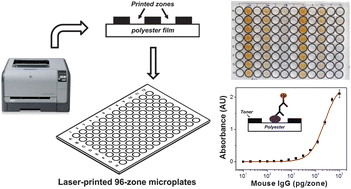Laser-printing of toner-based 96-microzone plates for immunoassays†
Abstract
This work describes the quick and simple fabrication of toner-based 96-microzone plates by a direct-printing technology. The printer deposits a toner layer (ca. 5 μm thick) on the polyester surface which acts as a hydrophobic barrier to confine small volumes of sample on test zones (wells). A 96-microzone toner plate was explored to demonstrate its capability of performing enzyme-linked immunosorbent assay (ELISA). The detection of anti-immunoglobulin G (anti-IgG) and immunoglobulin M (IgM) antibodies has been successfully achieved in cell culture and serum samples, respectively. The use of a conventional microplate reader has allowed obtaining a limit of detection of 13 fmol of mouse IgG per zone on printed microplates. The IgM antibody has been detected in a serum sample collected from a patient infected with dengue virus. The detection of a primary infection has been provided by a microplate reader and also by a cell phone camera. Besides the bioanalytical feasibility, toner-based zones have shown good repeatability for inter-zone and intra-plate comparisons. The relative standard deviation (


 Please wait while we load your content...
Please wait while we load your content...